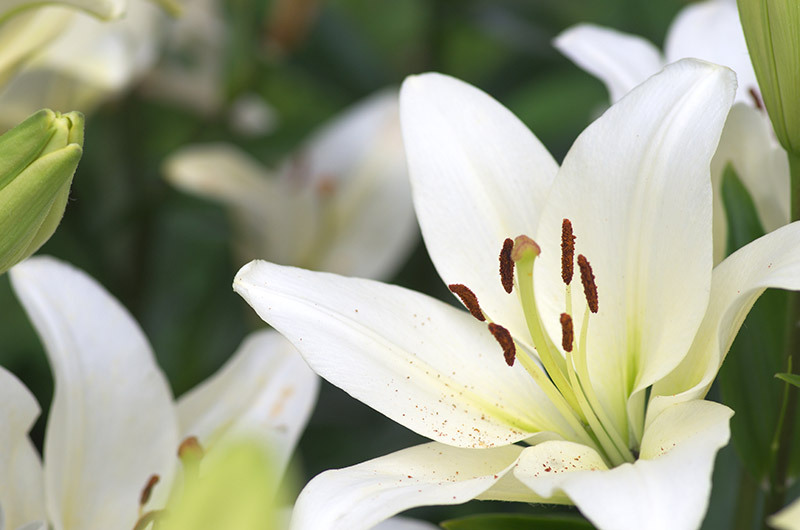Your roadmap to flourishing hydrangeas
Posted on 18/08/2025
Your Roadmap to Flourishing Hydrangeas: The Ultimate Guide
Hydrangeas are among the most beloved flowering shrubs in gardens worldwide, revered for their lush blooms and versatile beauty. Whether you are a seasoned gardener or just starting out, understanding the ins and outs of hydrangea care is essential for nurturing robust, vibrant plants. In this comprehensive roadmap, you'll unlock the secrets to flourishing hydrangeas-- from choosing the right varieties and optimal planting sites, to ongoing maintenance and expert tips to extend the blooming season. Ready to transform your garden? Let's begin your journey to spectacular hydrangeas!

Understanding Hydrangeas: Types and Key Features
Before diving into care instructions, let's clarify the different hydrangea varieties. This not only determines their looks, but also influences how you nurture them to encourage the healthiest growth and stunning blossoms.
Popular Hydrangea Varieties
- Hydrangea macrophylla (Bigleaf Hydrangea): Famous for their globe-shaped flowers, which shift color based on soil pH.
- Hydrangea paniculata (Panicle Hydrangea): Noted for cone-shaped blooms, they thrive in a wider range of climates and are often hardier.
- Hydrangea arborescens (Smooth Hydrangea): Known for easy care and new-wood blooming, such as the iconic 'Annabelle' variety.
- Hydrangea quercifolia (Oakleaf Hydrangea): With unique, oak-shaped leaves and elongated flower clusters, perfect for shady spots.
- Hydrangea serrata (Mountain Hydrangea): More petite, but with great color-shifting potential; ideal for cooler areas.
Key Features of Flourishing Hydrangeas
- Long blooming season: With proper care, enjoy vibrant flowers from late spring to early autumn.
- Versatility: Adaptable to pots, borders, and even as stunning focal points for landscape design.
- Color variety: From vivid blues and purples to soft white and pink hues, hydrangeas provide visual interest for any garden.
Step 1: Selecting the Right Hydrangea for Your Garden
Not every hydrangea variety will flourish under the same conditions. A vital first step in your roadmap to thriving hydrangeas is choosing a variety that matches your climate, garden size, and sunlight availability.
Factors to Consider:
- Climate hardiness: Some varieties are better for cold climates, while others prefer warmer areas.
- Soil type: Hydrangeas thrive in well-draining, fertile soil. However, some tolerate clay or sandy soil better.
- Desired color: Bigleaf hydrangeas are renowned for color modulation based on pH, offering blues in acidic and pinks in alkaline environments.
- Space: Consider the mature size of the plant--certain types like paniculatas can grow quite large.
Step 2: Preparing the Ideal Site & Soil
Location and soil are critical foundations for hydrangea success. Here's your in-depth guide for laying the groundwork:
Choosing the Best Location
- Partial sun is key: Most hydrangeas flourish in morning sun with dappled or afternoon shade. Intense, full-day sun can scorch leaves, while deep shade can limit blooms.
- Protection from wind: Avoid exposed sites where wind may damage delicate flowerheads.
Soil Preparation for Flourishing Blooms
- Enrich the soil: Amend with well-rotted compost or organic matter for nutrient-rich, moisture-retentive soil.
- Ensure drainage: Hydrangeas dislike soggy roots. If your soil is heavy clay, consider raised beds or amend with grit for better drainage.
- Test pH: Aim for slightly acidic to neutral (pH 5.5-7), especially if you want to control bloom color in macrophylla types.
Step 3: Planting Hydrangeas for Lasting Vitality
Planting correctly increases your chances of flourishing hydrangeas from the very start. Here's how to give them the best home:
Planting Instructions
- Dig a generous hole: Twice as wide (but not deeper) than the root ball to allow roots to spread easily.
- Mix in organic matter: Blend compost with excavated soil for a nutrient boost.
- Place the plant: Set at the same depth it was in its pot. Planting too deep can lead to rot.
- Backfill and water well: Ensure root contact with the soil and eliminate air pockets. Soak the area thoroughly after planting.
- Mulch: Add a 2-3 inch layer of bark or compost mulch to conserve moisture and regulate soil temperature.
Pro Tip: Plant hydrangeas in early spring or fall while the soil is warm and roots can establish before the stress of summer heat or harsh winter cold.
Step 4: Watering and Feeding to Promote Lush Growth
Providing the right water and nutrients is vital for healthy hydrangea growth throughout the seasons.
Watering Guidelines
- Keep soil consistently moist: Hydrangeas need regular watering, especially during dry spells. New plants should be watered deeply two to three times a week for the first season.
- Avoid waterlogging: Ensure good drainage to prevent root rot, which can spell disaster for your plants.
- Mulch helps: Retains moisture and reduces the need for frequent watering.
Feeding for Blooms
- Balanced fertilizer: Use a granular fertilizer designed for flowering shrubs in early spring. Feed again in early summer if needed, but avoid late-season feeding to reduce frost risk.
- Compost: An annual layer of compost adds nutrients and encourages beneficial soil life, resulting in vigorous, disease-resistant plants.
Step 5: Pruning and Maintenance - The Secret to Abundant Flowers
Pruning doesn't need to be intimidating--knowing when and how to prune promotes both health and impressive blooms.
General Pruning Rules
- Know your type: Prune Hydrangea macrophylla and Hydrangea serrata just after flowering because they bloom on old wood. Paniculata and arborescens varieties flower on new wood, so prune these shrubs back aggressively in late winter or early spring for maximum blooms.
- Remove deadwood: Regularly snip out dead or diseased stems to improve air circulation and reduce pest issues.
- Shape: Lightly shape after the blooming period to maintain the desired size and form.
Pro Maintenance Tips
- Deadheading: Removing spent flowers not only tidies up the shrub but can also encourage repeat blooming in some varieties.
- Checking for pests: Watch for aphids, spider mites, or powdery mildew. Address quickly with eco-friendly treatments.
- Refreshing mulch: Reapply mulch each spring to keep roots cool and moist while suppressing weeds.
Step 6: Hydrangea Color Magic - Adjusting Bloom Hues
One of the wonders of macrophylla hydrangeas is their ability to change color based on soil pH. Want vivid blues or charming pinks?
How to Adjust Hydrangea Bloom Color
- For blue flowers: Add aluminum sulfate to lower the soil pH (increase acidity).
- For pink flowers: Add garden lime to raise the soil pH (increase alkalinity).
- Test your soil: Always check pH before making adjustments! Most hardware stores sell simple soil testing kits.
Note: White hydrangeas typically remain white regardless of soil pH.
Step 7: Overwintering and Seasonal Protection
Ensuring your hydrangeas survive and thrive through winter is vital for long-term success:
- Mulch deeply: Apply a thicker mulch layer in late autumn to insulate roots against freezing temperatures.
- Burlap wraps: In very cold regions, protect younger plants with breathable burlap covers to shield from snow and wind.
- Water before frost: Hydrangeas should have moist soil heading into winter; dry roots can suffer more damage from cold.
Troubleshooting Common Hydrangea Issues
Sometimes, even with your best efforts, hydrangeas may struggle. Here's how to spot and fix frequent problems:
Problems and Solutions
- Wilting in afternoon sun: Ensure rooted mulch and adequate watering. Sometimes, midday droop is normal but the plant should recover in the evening.
- No blooms: Over-pruning, late frost, or insufficient light can prevent flowering. Identify the cause and adjust care accordingly.
- Leaf spots or mildew: Encourage air circulation and avoid overhead watering. Remove affected leaves promptly.

Long-Term Success: Top Expert Pro Tips for Hydrangea Mastery
- Rotate varieties: Incorporate multiple hydrangea types for extended blooming and visual diversity.
- Use hydrangeas in containers: Great for small gardens or patios, allowing easy relocation for optimal sun exposure.
- Regular monitoring: Consistently check soil moisture and plant health, especially in the first few seasons.
- Enjoy cut flowers: Harvest blooms for indoor arrangements--cut early in the morning for the longest vase life.
Fun Fact:
Some hydrangeas develop attractive fall foliage, adding a burst of color even after the flowers fade!
Conclusion: Charting Your Path to Spectacular Hydrangea Gardens
With the right knowledge and a touch of patience, flourishing hydrangeas can be the shining centerpiece of your landscape, rewarding you with vivid blooms year after year. Remember: a flourishing hydrangea garden is built on the foundations of variety selection, smart siting and soil, proper watering and feeding, attentive pruning, and seasonal care. Troubleshoot early problems, embrace the magic of color-changing blooms, and enjoy sharing your garden's bounty with friends and neighbors.
Your roadmap to hydrangea success begins here--start today and watch your garden come to vibrant life!
- Want more tips? Subscribe to our newsletter and receive monthly updates on hydrangea care and other garden favorites!
- Share your hydrangea journey in the comments below or tag us on social media with #FlourishingHydrangeas!
Happy gardening & enjoy your beautiful, thriving hydrangeas!
Latest Posts
Best Flower Shops Near [LANDMARK/NEIGHBOURHOOD]: A Local's Guide
Discover Easy Flower Preservation for Lasting Beauty
New Insights: 7 Facts About Tulips





